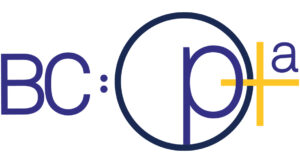Highlights
- Proven process intensification solutions can often be deployed within the existing wastewater treatment infrastructure to increase capacity, improve effluent quality, provide chemical and energy savings, and support resource recovery.
- The research, WRF Project #5071, “Demonstration of Progressive Carbon Efficient Nitrogen with Biological Phosphorous Removal in a Conventional BNR Facility,” shows that innovative process control and optimization can maximize influent carbon utilization for nitrogen and phosphorous removal.
- Utilities that are adopting innovative process intensification technologies are optimizing their wastewater treatment plant to do more with less.
With innovative process control, wastewater utilities have a powerful new optimization tool that can help their treatment plants do more with less while meeting stringent nutrient limits.
“The results are really powerful. When WRRFs combine optimization and a proven innovative process intensification solution like ammonia-based aeration control (ABAC) to maintain controlled dissolved oxygen (DO) levels, it can lead to significant simultaneous nitrification/denitrification (SND) for efficient nutrient removal.”
Brown and Caldwell (BC) Senior Process Engineer and Wastewater Innovation Leader Dr. Pusker Regmi
This optimized innovative process control — BC:Ntensify’s low DO aeration control — can help utilities maximize their infrastructure, improve effluent quality, provide chemical and energy savings, support resource recovery process intensification, and reduce environmental impact.
“We basically asked: Can we use metabolism-driven aeration control to allow for low DO in BNR systems to get carbon-efficient and energy-efficient treatment while doing simultaneous nitrification and denitrification to save energy and chemicals?” explains Ahmed Al-Omari, BC National Biological/Chemical Wastewater Treatment Lead. “The answer was a resounding yes.”
Water Research Foundation Project #5071
Both Dr. Pusker and Al-Omari are investigators for the award-winning Water Research Foundation Project #5071, “Demonstration of Progressive Carbon Efficient Nitrogen with Biological Phosphorous Removal in a Conventional BNR Facility,” the basis of this groundbreaking research that aims “to integrate carbon-efficient nitrogen (N) removal processes with biological phosphorus (bio-P) removal within a conventional biological nutrient removal system,” according to the project’s abstract.
“It is about carbon management and using ABAC to ensure available carbon is optimally utilized for nutrient removal and not wasted” Al-Omari emphasizes.
In partnership with Northwestern University and Washington Suburban Sanitary Commission, the $300,000 study “will demonstrate, at full-scale, the use of innovative process control and optimization to (1) maximize influent carbon utilization for N and P removal rather than aerobic oxidation, (2) integrate bio-P removal and shortcut N removal/simultaneous nitrification and denitrification for energy and carbon efficient complete nutrient removal, and (3) explore impact of low DO on denitrification capacity in post anoxic zone.” (Figure 1)
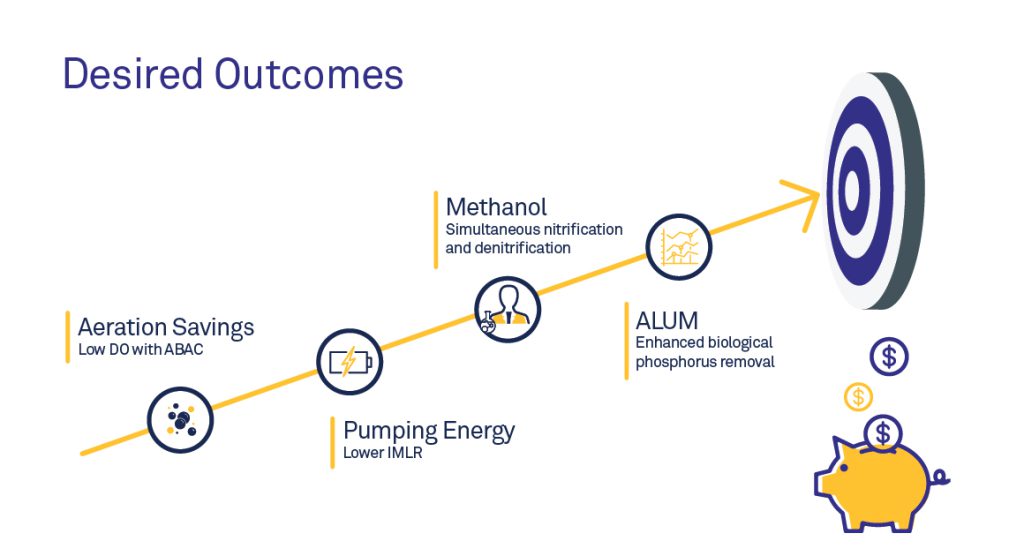
Figure 1
Benefits
The science behind this system is significant for utilities that are facing pressures from:
- More stringent nutrient regulations and compliance limits
- Population growth
- Budget constraints
- Rising customer rates
- Aging infrastructure
- Climate change
By optimizing innovative process control systems such as ABAC, utilities are able to maximize their existing facility footprint, meet current and future nutrient limits while using fewer chemicals and less energy adding up to substantial operational cost savings.
As proven at a WRF award-winning facility in the Southwestern United States, process intensification solutions can often be deployed within existing infrastructure. WRF Project #5071 builds upon that success by setting these goals:
- Maximize influent carbon utilization for N and P removal rather than aerobic oxidation.
- Integrate biological P removal and SND for energy and carbon efficient complete nutrient removal.
- Maximize capacity of post anoxic zone to improve nitrogen removal.
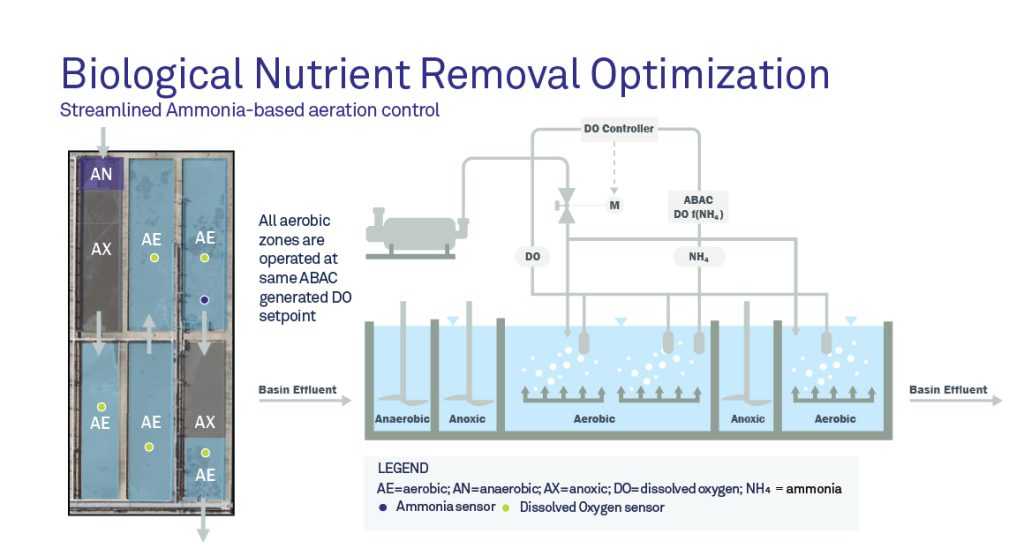
Figure 2
To meet these goals, the treatment facility converted one of its five process trains to a test train with the following modifications (Figure 2):
- Internal mixed liquor recycle (IMLR) reduced from 400% to 200% of the influent flow.
- ABAC control to allow for low DO levels in all aerated zones, including reaeration zone.
- Methanol addition discontinued in the post-anoxic zone.
- Decreased post anoxic zone volume from 17% to 9% of the reactor basin.
The experimental plan included the use of state of the art data analysis and testing to understand the mechanisms and the fate of carbon transformations throughout the process.
Implementation was quick and easy and only took about a week because the facility already had sensors, leveraged its existing infrastructure, and the staff was knowledgeable about process control programming.
Results
Within a few months the test produced excellent effluent quality without supplemental chemicals, low DO yielded significant aeration savings and favorable conditions for SND, low DO Bio-P, and post-denitrification without supplemental carbon. (Figures 3-4)
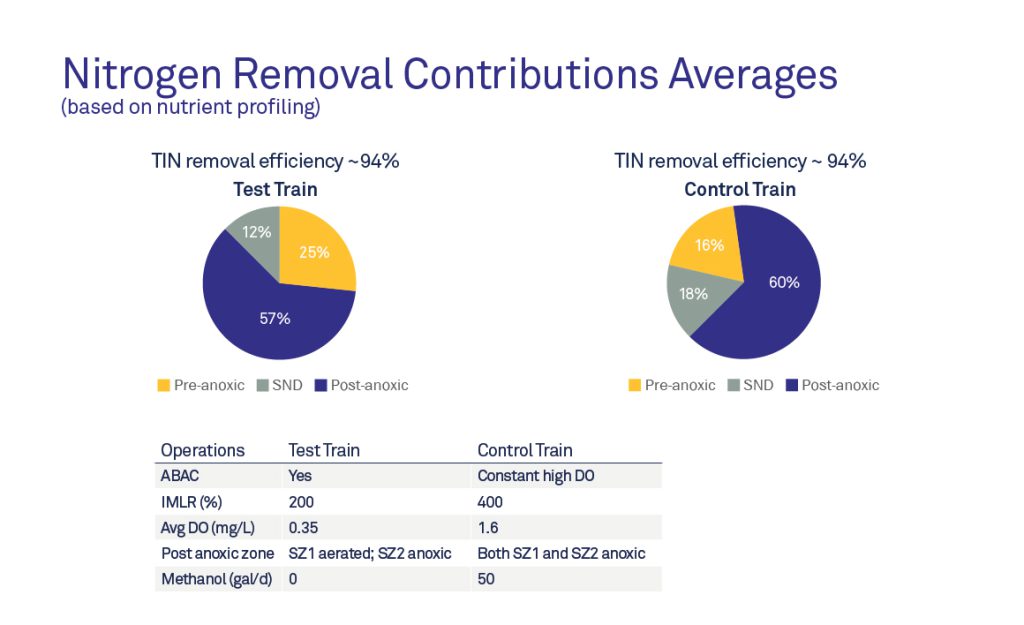
Figure 3
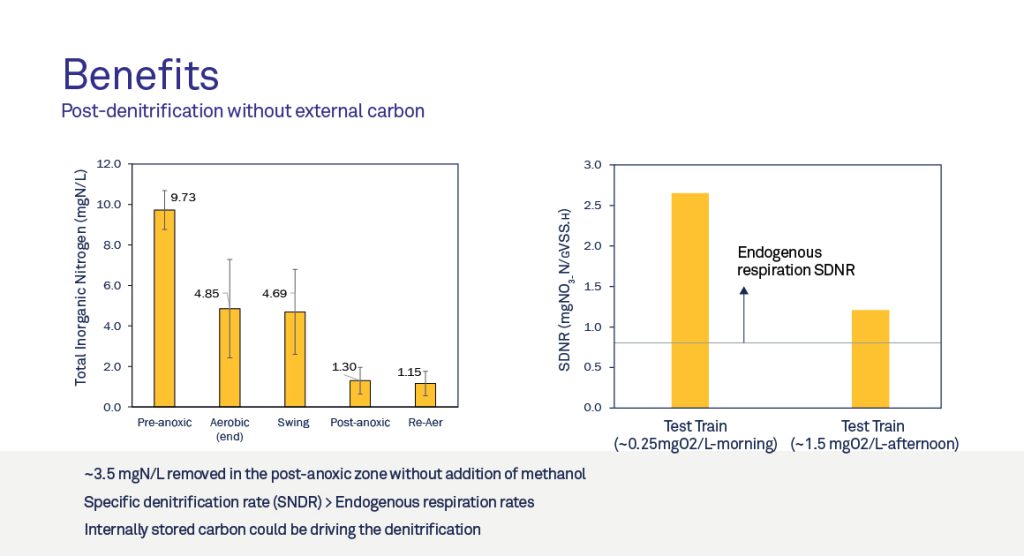
Figure 4
“The benefits are that you can enhance nutrient removal while at the same time saving a lot of energy by using low DO,” Dr. Pusker explains further. “We still get TIN (total inorganic nitrogen) reduction in the post-anoxic zone without adding carbon, meeting less than 2 mg/L TIN comfortably with low DO and no chemicals. Then you have excellent P uptake, which happens right away. The key is the preanoxic zone facilitating both nitrogen removal and P release. That’s amazing.”
BC:Ntensify solution
By optimizing its treatment process and leveraging existing infrastructure, the utility was able to save 35% in aeration energy costs, 50% in IMLR, 100% methanol for N removal as well potentially saving 100% alum for P removal. (Figure 5)
“This process optimization takes innovative solutions like ABAC SND, proves them through scientific rigor, and enhances it with a people-focused implementation strategy.”
BC National Biological/Chemical Wastewater Treatment Lead Ahmed Al-Omari
That’s what makes BC’s approach to optimization, BC:Opta™, unique. It goes beyond process designs and data points to combine people + technology + adoption. By using BC:Opta’s specialized framework, the team was able to collaboratively deliver a BC:Ntensify® process intensification solution quickly and effectively.
“In the beginning, we had weekly calls with staff to go over the data and listen to what was and wasn’t working,” Pusker says. “Slowly and surely the operator became our biggest champion. It’s magical to see that transformation from initial skepticism.”
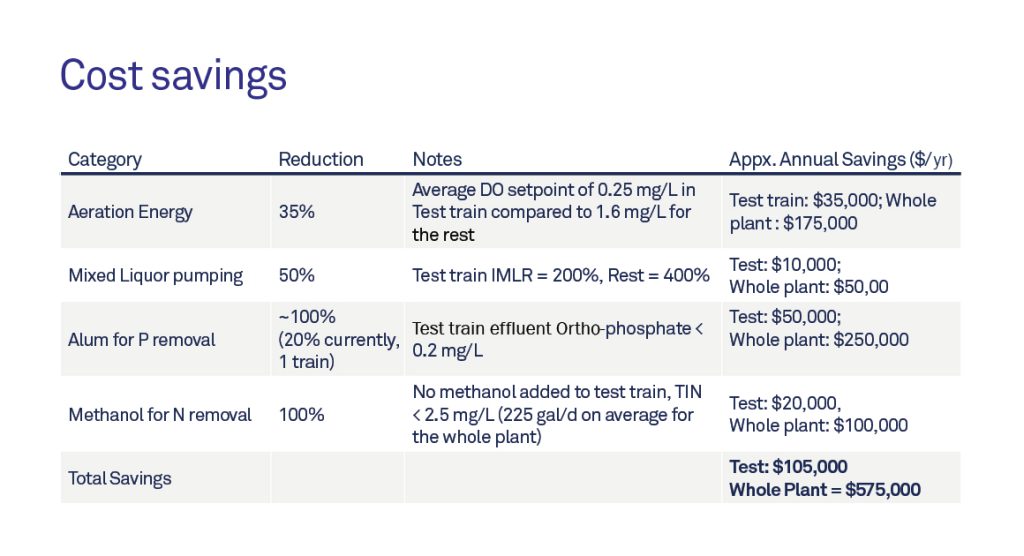
Figure 5
The future
The ABAC SND aeration control low DO system is just one of BC:Ntensify’s suite of process intensification solutions that are helping facilities to sustainably meet existing and future nutrient regulations, save costs, and reduce their environmental impact.
As part of WRF Project #5071, which is slated to conclude in 2023, the data and results are continuing to build with more promising benefits under investigation.
“What is the true potential of the low DO system alone?” Dr. Pusker asks. “There could be more benefits with this mode of operation including selecting for specialist organisms, doing more fermentation and internal storage of carbon that can be used for both P and N removal. All of those could be happening here as well, which is helping the process overall.”



